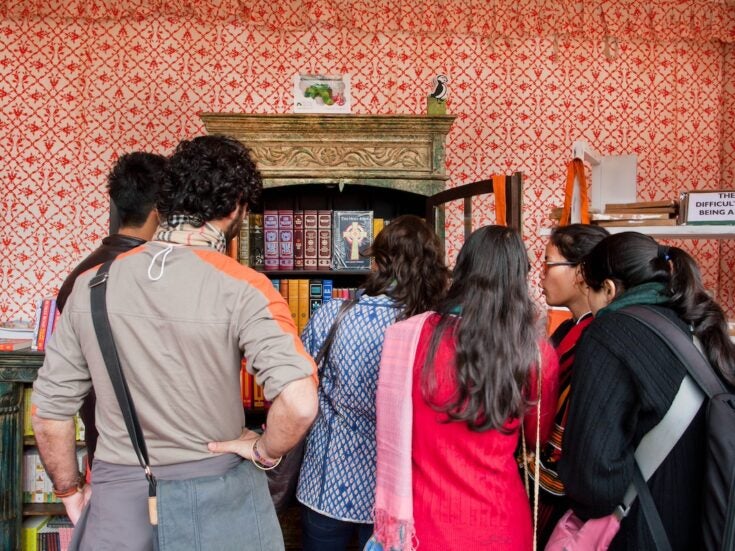

The Wellcome Collection’s latest exhibition, States of Mind, inhabits a misty no-man’s-land between the realms of science and theory. It’s a vast undiscovered country, revealing and concealing itself all at once, the Terra Australis for cartographers of consciousness. And, loosely, it is the historical journey of those cartographers we follow, in whatever form that may take: philosopher, artist, scientist, all given licence to seek the concealed interior.
The four rooms resemble psychological mindspaces, pink and womb like, scattered and uncentred, a concentric circle and the obligatory long dark corridor. On entering, first into the womb, it is the philosopher Descartes we meet, his etching of the brain’s Pineal Gland rendering his belief in its role as a harbour for our consciousness – a physical knowledge container, inherently a marker of what we don’t know as well. Descartes is predictably joined by William Blake, the great mystic, whose image of the soul hovering over the body holds a timelessness, a sense of pawing at preconceptions, a female soul, a town couched in the lee of the mountain, patronage to a greater being and a greater, unseen, knowing.

That knowing is not found by the close of this exhibition. This is not a story of ‘we were there, now we are here – science the redeemer’ but an acknowledged signposting of consciousness’ slippery paths made more, not less, treacherous by our growing knowledge. It’s a prudent interpretation, preventing the exhibition from dictating. Rather it reveals, speaking to individual minds through the aggregation of artistic and scientific experience.
This is wonderfully traced by the draftsmanship of Santiago Ramon y Cajal, a founder of neuroscience and exquisite drawer of the nervous system – his skilled hand detailing strange, alien-like abstractions reminiscent of something from Duchamp’s The Bride Stripped Bare by Her Bachelors Even. These lines to Modernity are seen in the welcome referencing of Kandinsky’s work and Nabokov’s synaesthesia as detailed by the artist Holabird’s coloured alphabet paired with the Russian writer’s script: ‘S is not the light blue of C – but a curious mixture of azure and mother of pearl.’ We also see the terror of sleep paralysis and Modern art’s framing of fear in a world beginning to look behind society’s mental veils. The 1920 somnambulist horror film ‘The Cabinet of Dr Caligari’ seems to be set largely inside the psychotechnic prison cells used by the Spanish Republic a generation later.
Nabokov, the émigré speaking a new language, had a very 20th century life. Thinking of his work and that of so many other artists it’s impossible not to think of the baring Freud, and the advent of psychoanalysis, had on their movements – Yet psychology is itself barely referenced. However this is no denial of its weight says curator Emily Sergant, who points to the importance of psychology throughout, especially at the exhibit’s close where the exhibition aims to ‘prioritise personal voices – rather than to limit the subject of consciousness to what neuroscience can tell us.’
Mary Kelly’s descriptive ‘Post-Partum Document’ (1973-9), is a corridor itself into received language, detailing her son’s efforts to grasp the world around him with blunt letters. This theme is further explored by Imogen Stidworthy’s ‘The Whisper Heard’ (2003), an astounding installation featuring an infant and a stroke patience reading a passage from Jules Verne’s ‘Journey to the Centre of the Earth’. It shows their mixed palettes of verbal paint, each reading a guide to a state of mind. It is a disorientating, poignant dismantling of perspective.
Like language, memory’s brittle shell is also cracked, Shona Illingworth’s set of digital images taken by an amnesia patient’s sensory camera show us a life forgotten by itself, resonating all the more loudly as the images depict a journey to the abandoned Atlantic isle of St Kilda. Collective, subconscious, memories are also examined – the caustic effect of social trauma is seen in the ‘Fragments’ story of holocaust survivor Binjamin Wilkomirski aka Bruno Dössekker a Swiss with no proof of ever being in a concentration camp. An exhibit asking not how painful the truth but how truthful the pain in subjective memory.
Geography of thought returns at close in Durand’s ‘Wander Lines’, images made to trace memory, maps blending space and time and indecipherable beyond proving an enigma. And that of course is the point: Sargent mentions the need to examine the ‘boundary between knowledge and experience’. This exhibition gives its visitors a valuable description of those boundaries, and thereby unknown interiors, showing how far the light from our torches still has to travel in this universe. As Sargent says, the exhibits of modern medical techniques show ‘that we are at the very beginning of understanding the nuances of consciousness from a scientific point of view.’ However, we are fortunate to have such an illuminating atlas as this.
States of Mind is on at the Wellcome Trust until October 2016







